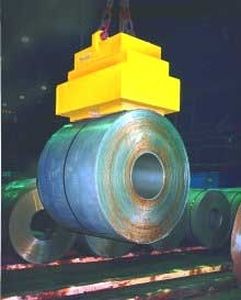
Electrically switched electro lifting magnet COILMASTER®for coilsrectangular

Add to favorites
Compare this product
Characteristics
- Type of commutation
- electrically switched
- Applications
- for coils
- Shape
- rectangular
Description
Magnetic lifting is the easiest, fastest and most economical method of handling coiled strip steel. Traditional mechanical lifting devices can damage several layers of in the process of gripping the coil, and damage can also take place when the coil is released. Properly designed lift magnets virtually eliminate the possibility of damage.
Much less storage space is required for magnetic handling, since a magnet lifts the coil from directly above the load, eliminating the need for aisle space required by mechanical lifting devices. One crane or truck operator can usually load, transport and unload coils without assistance from the floor, freeing up manpower to be used elsewhere.
Various magnet designs can be utilized for lifting coiled steel, depending on the orientation (eye vertical, or eye horizontal), the gage of the steel, the size and weight of the coil, it’s temperature, and whether it is banded or loosely wound. The Coilmaster is available in two basic designs, electromagnets and electropermanent magnets. Electromagnets are the traditional design that requires a constant source of D.C. power when energized. These magnets tend to perform well in applications where the surface condition of the coil is irregular, such as a significant amount of edge stagger. Pound for pound, electromagnets will provide the greatest lift to weight ratio of any type of magnet, thus crane capacity can be optimized.
Electropermanent magnets utilize permanent magnetic material surrounded by an electrically powered coil.
Catalogs
Related Searches
- Lifting magnet
- Lifting electromagnet
- Electrically switched electro lifting magnet
- Handling lifting electromagnet
- Permanent lifting magnet
- Manually switched permanent lifting magnet
- Handling permanent lifting magnet
- Rectangular lifting electromagnet
- Permanent magnetic lifter
- Scrap handling electro lifting magnet
- Sheet metal lifting electromagnet
- Coil electro lifting magnet
- Scrap magnet
- Beam electro lifting magnet
- Fixed beam electro lifting magnet
- Manually switched electro lifting magnet
- Handling permanent magnetic lifter
- Billet electro lifting magnet
- Pipe electro lifting magnet
- Hot steel electro lifting magnet
*Prices are pre-tax. They exclude delivery charges and customs duties and do not include additional charges for installation or activation options. Prices are indicative only and may vary by country, with changes to the cost of raw materials and exchange rates.



